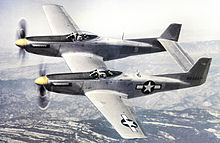Early seaplanes
A twin-float arrangement offers stability on the water without the need for wing tip stabilising floats. Mounting the float immediately below, or integrally with, the fuselage provides a strong airframe with minimal additional weight. During and after World War I a number of such twin-fuselage floatplanes and twin-hulled flying boats were constructed, and a few entered production.
As early as 1913, the Radley-England Waterplane racing flying boat demonstrated the concept at the hands of pilot Gordon England.
The Twin Blackburn of 1915 was a long-range floatplane for anti-Zeppelin patrol. A handful of production examples were delivered but few were used operationally.
Savoia-Marchetti produced two twin-hulled flying boat types. The S.55 multirole flying boat first flew in 1924. It was built in large numbers, including both civil and military variants. The later S.66 airliner of 1931 sold less well.
Heavy fighters
During World War II a need arose for a heavy fighter, which could not be met by a new design proposal in a reasonable time frame. Joining two examples of an existing light fighter aircraft was one way to achieve this.
The German Messerschmitt Bf 109Z twin (Zwilling) Bf 109 prototype was destroyed in an attack by the British in 1943 before it was completed, and the project subsequently abandoned. The later Me 609 twin Me 309 project was never built.
In 1944 Dornier proposed the Dornier Do 635 long-range reconnaissance variant of the Do 335 Pfeil heavy fighter, to have twin Do 335 fuselages and four engines. It was never built.
The Italian Savoia-Marchetti SM.92 prototype was unusual in being an adaptation of a twin-boom design but did not enter production.
The North American F-82 Twin Mustang arrived too late to enter service during the War but later saw service in the Korean War.
Space launchers
More recently the idea of a dedicated re-usable large mothership, capable of carrying and launching a spacecraft, has gained interest. The twin fuselage configuration offers the advantage of a clean payload area underneath the wing centre section, without the need for exceptional ground clearance beneath the fuselages.
Early concepts included the Conroy Virtus and Twin-fuselage Lockheed C-5 Galaxy Shuttle transport aircraft of 1974.
Following the success of the Scaled Composites White Knight prototype the White Knight Two is under development, with the first example being used to flight-test the SpaceShipTwo suborbital passenger craft.
The Scaled Composites Stratolaunch, informally known as the Roc , has the longest wingspan of any aircraft ever flown, at 385 feet (117 m). It is owned by Stratolaunch Systems, who are currently developing the air-launched spacecraft envisaged as its payload.
NASA have flown a scaled-down demonstrator of a rocket-assisted Towed glider air-launch system, in which the laden twin-fuselage mothership is towed to altitude as a glider and released. Its rocket engine then ignites, propelling it to a speed and altitude greater than those of the tow plane. The payload spacecraft is then released.
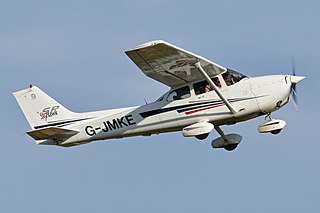
An aircraft is a vehicle that is able to fly by gaining support from the air. It counters the force of gravity by using either static lift or the dynamic lift of an airfoil, or, in a few cases, direct downward thrust from its engines. Common examples of aircraft include airplanes, helicopters, airships, gliders, paramotors, and hot air balloons.

A fixed-wing aircraft is a heavier-than-air aircraft, such as an airplane, which is capable of flight using aerodynamic lift. Fixed-wing aircraft are distinct from rotary-wing aircraft, and ornithopters. The wings of a fixed-wing aircraft are not necessarily rigid; kites, hang gliders, variable-sweep wing aircraft, and airplanes that use wing morphing are all classified as fixed wing.
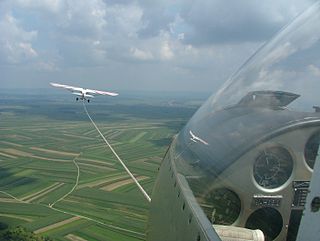
In aviation, assisted takeoff is any system for helping aircraft to get into the air. The reason it might be needed is due to the aircraft's weight exceeding the normal maximum takeoff weight, insufficient power, insufficient available runway length, or a combination of all three factors. Assisted takeoff is also required for gliders, which do not have an engine and are unable to take off by themselves.

The Messerschmitt Me 321 Gigant was a large German cargo glider developed and used during World War II. Intended to support large-scale invasions, the Me 321 had very limited use due to the low availability of suitable tug aircraft, high vulnerability whilst in flight, and its difficult ground handling, both at base and at destination landing sites. The Me 321 was developed, in stages, into the six-engined Messerschmitt Me 323 Gigant, which removed some of the problems with ground handling, although the payload was reduced. Vulnerability to ground fire and aerial attack remained a constant problem during operations of all variants.

The Messerschmitt Me 323 Gigant ("Giant") was a German military transport aircraft of World War II. It was a powered variant of the Me 321 military glider and was the largest land-based transport aircraft to fly during the war. In total, 213 were made, with 15 being converted from the Me 321.

Caproni, also known as Società de Agostini e Caproni and Società Caproni e Comitti, was an Italian aircraft manufacturer. Its main base of operations was at Taliedo, near Linate Airport, on the outskirts of Milan.
The maiden flight, also known as first flight, of an aircraft is the first occasion on which it leaves the ground under its own power. The same term is also used for the first launch of rockets.

A triplane is a fixed-wing aircraft equipped with three vertically stacked wing planes. Tailplanes and canard foreplanes are not normally included in this count, although they occasionally are.
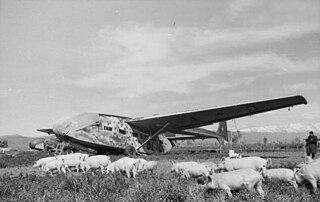
The Gotha Go 242 was a transport glider used by the Luftwaffe during World War II. It was an upgrade over the DFS 230 in both cargo/troop capacity and flight characteristics. It saw limited combat action. There were multiple glider variants, and it became the basis for a transport aircraft, the: Gotha Go 244.

The Yakovlev Yak-12 is a light multirole STOL aircraft used by the Soviet Air Force, Soviet civilian aviation and other countries from 1947 onwards.

The Caproni Ca.60 Transaereo, often referred to as the Noviplano (nine-wing) or Capronissimo, was the prototype of a large nine-wing flying boat intended to become a 100-passenger transatlantic airliner. It featured eight engines and three sets of triple wings.

The Junkers Ju 322 Mammut was a heavy transport military glider, resembling a giant flying wing, proposed for use by the Luftwaffe in World War II; only two prototypes were completed, a further 98 were scrapped before completion.

The Dornier Do 214 was a proposed large long-range flying boat, developed by Dornier in World War II.
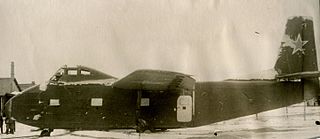
The Yakovlev Yak-14 was the largest assault glider ever to enter service with the Soviet Air Force. It was introduced in 1949, at a time when other air forces were abandoning the glider concept. In 1950 a Yak-14 became the first glider to fly over the North Pole.
The Fouga CM.88 Gemeaux was a 1950s French engine test-bed aircraft produced by Fouga. An unusual aircraft, it was two aircraft joined by a common wing.

A glider is a fixed-wing aircraft that is supported in flight by the dynamic reaction of the air against its lifting surfaces, and whose free flight does not depend on an engine. Most gliders do not have an engine, although motor-gliders have small engines for extending their flight when necessary by sustaining the altitude with some being powerful enough to take off by self-launch.

Stratolaunch LLC is a private American aerospace company providing high-speed flight test services. It was founded in 2011 to develop a new air-launched space transportation system, with its corporate headquarters in Seattle. The company and development project were announced in December 2011 by Microsoft co-founder Paul Allen and Scaled Composites founder Burt Rutan, who had previously collaborated on SpaceShipOne. After ten years, the company was acquired in 2019 by Cerberus Capital Management and has continued privately funded, operating as a non-traditional defense contractor.

The Scaled Composites Model 351 Stratolaunch or Roc is an aircraft built by Scaled Composites for Stratolaunch Systems to carry air-launch-to-orbit (ALTO) rockets, and subsequently repurposed to offer air launch hypersonic flight testing after a change of ownership. It was announced in December 2011, rolled out in May 2017, and flew for the first time on April 13, 2019, shortly after the death of founder Paul Allen. The aircraft features a twin-fuselage design and the longest wingspan ever flown, at 385 feet (117 m), surpassing the Hughes H-4 Hercules "Spruce Goose" flying boat of 321 feet (98 m). The Stratolaunch is intended to carry a 550,000-pound (250 t) payload and has a 1,300,000-pound (590 t) maximum takeoff weight.

Towed glider air-launch system is a NASA-designed two-stage air-launched reusable launch system currently in development at NASA's Armstrong Flight Research Center. The system uses a glider, tow plane, and rocket and is designed to carry small satellites to orbit. Both the glider and tow plane are reusable.
